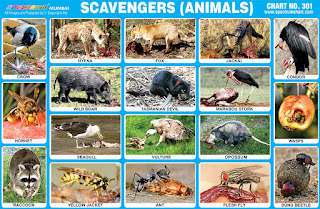Crow - Crows form the genus
Corvus in the family Corvidae. They are medium to large sized birds,
carnivores and scavengers. Crow is found on all temperate continents
except for South America and some islands. Crows are thought to be,
with parrots, among the world's most intelligent birds.
Hornet - Hornets are the
largest eusocial wasps. They are found mainly in the Northern
Hemisphere. Hornets have stings used to kill prey and defend hives.
Raccoon - Raccoon are
native to South and North America. They have greyish fur, black mask
around eyes and long tail covered with black and brown bands.
Because of their tail, they are nicknamed "ringtail". They
are omnivores and nocturnal creatures.
Hyena - Hyenas
are large, dog-like, carnivores. They live in savannas, grasslands,
sub-deserts and forests of Africa and Asia. They are nocturnal
animals. Hyenas are cannibals. They may attack and eat other hyenas,
especially when they are young.
Fox - The fox is a
scavenger carnivorous dog. Foxes are characterised by sharp muzzle
and fluffy tail. Colour of the fur can be red, brown, black, grey,
silver or white. Tip of the tail is always white. Tips of their ears
and feet are always black. Fox is a nocturnal mammal. Fox tend to
live for 6 – 7 years.
Jackal - Jackal
is a member of a canine family. It can be found in Africa, Middle
East, India and Europe. Body of jackal is covered with golden, rust
or silver-coloured black fur. Jackals have bushy tail. Jackals are
territorial animals. They mark and defend their territory fiercely.
Wild Boar - Wild boar is a
close relative of domestic pig. Wild boars can survive in different
types of habitat like grasslands, taiga, tropical rainforests, but
they prefer life in deciduous forests. Body of wild boars is covered
with double coat of fur that can be brown, red, black or grey. Upper
coat is composed of harsh, bristly hair. Undercoat is much softer.
Wild boar is an omnivore. It feeds mainly on the seed, fruits,
leaves, berries, eggs, mice, lizards, worms and snakes.
Tasmanian Devil - Tasmanian
devil is the largest marsupial carnivore. It can be found only on
the island of Tasmania (Australia). They prefer coastal scrublands
and forests. Body of Tasmanian devil is covered with black fur, with
white patches on the chest, shoulders and rump. Tasmanian devil has
large head and very strong jaw. Tasmanian devil is a carnivore.
Marabou Stork - Marabou
Stork is a large wading bird in the stork family Ciconiidae. Marabou
stork is a massive bird, large specimens are thought to reach a
height of 152 cm and a weight of 9 kg. It breeds in Africa, south of
the Sahara, in wet and arid habitats, often near human habitation,
especially waste tips.
Seagull - Seagull is a type
of sea bird. There are over 20 species of seagulls. Body of most
seagulls is covered with white plumage. Wingtips are usually black
or dark in colour. Some species are grey or entirely white. Seagull
has strong body, elongated legs and webbed feet. Beak is slightly
hooked and usually yellow in colour. Seagulls are one of the rare
animals that are able to drink salt water. Seagulls can survive from
10 to 15 years in the wild.
Vulture - Vultures are
large birds of prey that usually feed on carrion (dead or dying
animals and rocks). Vultures use their large wings to soar in the
air for many miles without having to flap. Vultures are also called
buzzards. Vultures are widely distributed, but they are absent from
Australia and most oceanic islands.
Opossum - Opossums are
medium sized animals with pouch. They are the only marsupials that
live in North America and Canada. Opossums prefer woodlands near
streams, rivers, marshes. Their body is covered with white-greyish
fur. Opossums have more teeth than other mammals i.e. 50. They are
omnivore.
Yellow Jacket - Yellow
jacket is the common name in North America for predatory wasps of
the genera Vespula and Dolichovespula. Yellow jackets are social
hunters living in colonies containing workers, queens and males. The
diet of the adult yellow jacket consists of items rich in sugars and
carbohydrates, such as fruits, flower nectar and tree sap.
Ant - Ants range in size
from about 2 mm to 25 mm. Their colour is usually yellow, brown, red
or black. Ants are most common insects found in every neighbourhood.
Flesh Fly - Flies in the
family Sarcophagidae are commonly known as flesh flies. Most flesh
flies are tropical, although the family is generally widespread.
Many species are scavengers, with the larvae developing on either
open wounds or carrion. Depending on the species, the female
deposits live larvae or eggs.
Condor - Condor is a New
World vulture, the largest North American land bird. Condor is a
uniform black with the exception of triangular patches or bands of
white on the underside of the wings. It has grey legs and feet, an
ivory-coloured bill, a frill of black feathers near the base of the
neck and brownish red eyes.
Wasps - Wasp is known for
its black and yellow markings. They are most commonly known for its
poisonous sting. Wasps are omnivorous.
Dung Beetle - Dung beetles
are beetles that feed partly or exclusively on dung. Their size vary
from 5 to 30 mm and are usually dark in colour.


No comments:
Post a Comment